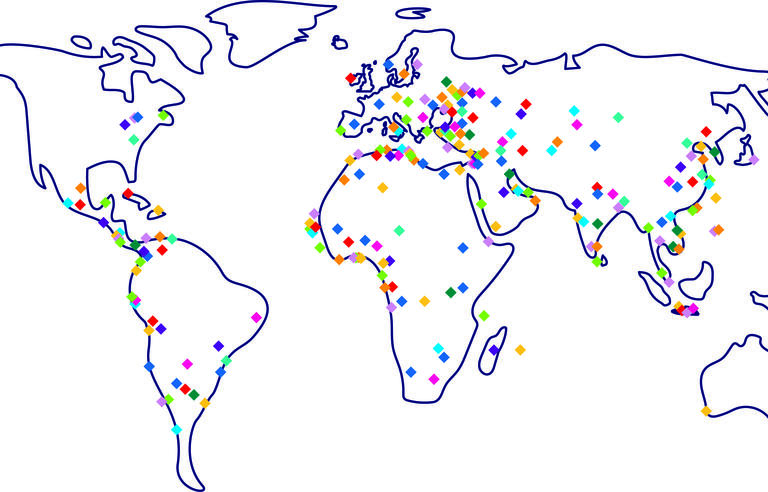
Major trends in student mobility in Europe
As part of the “Rencontres Campus France 2020” (Campus France Meetings 2020), the Campus France research department released a note on the major trends in student mobility in Europe. The study provides an analytical tool for an informed construction of the attractiveness policy of French higher education to European students.
La mobilité étudiante est un élément constitutif de l’histoire du continent européen, que l’épidémie de Covid-19 a durablement perturbé. Les mobilités de proximité et de court terme connaissent un fort regain d’intérêt d’autant qu’elles sont facilitées au sein de l’UE. A travers l’étude des grandes tendances de la mobilité étudiante en Europe, Campus France propose un outil d’analyse qui permet d’accompagner les établissements d’enseignement supérieur qui sont amenés à réorienter leur stratégie internationale en concentrant leurs efforts sur cette région, ses établissements et ses étudiants.
L’Europe : 1ere destination des étudiants internationaux
D’après les chiffres de l’Unesco, L’Europe est la 1ere zone d’accueil des étudiants mobiles avec plus de 2,4 millions d’étudiants accueillis en 2018, devant l’Amérique du Nord. Trois quarts de ces étudiants viennent de l’Union Européenne. Carrefour des mobilités, l’Europe est également la deuxième zone d’envoi des étudiants en mobilité, après l’Asie, avec 1,3 millions d’étudiants qui partent étudier dans un autre pays.
Quatre pays, le Royaume-Uni, l’Allemagne, la Russie et la France accueillent plus de la moitié de la mobilité étudiante en Europe. A noter que des pays comme la Turquie (+130%) et la Pologne (+96%) connaissent une très forte croissance des effectifs d’étudiants en mobilité accueillis entre 2013 et 2018.
L’Europe attire des étudiants de tous les continents. La Chine est le premier pays d’origine des étudiants internationaux en mobilité en Europe (10% des effectifs) et l’Inde (3e) a vu le volume de ses étudiants doubler en Europe. Cependant, en Europe, un étudiant international sur deux est un étudiant européen.
A l’intérieur de l’Europe, la Russie est le premier pays d’accueil de cette mobilité étudiante, notamment des étudiants de l’ex-URSS. La Turquie (+153%) et la Pologne (+94%) se distinguent encore une fois par la forte croissance d’étudiants européens accueillis entre 2013 et 2018.
En ce qui concerne le programme Erasmus +, 325 000 étudiants ont réalisé une mobilité dans ce cadre en 2017-2018. L’Espagne demeure en tête du classement des destinations d’études, devant l’Allemagne, le Royaume-Uni et la France, qui elle, continue d’être le premier pays d’origine des étudiants Erasmus+.
L’essentiel des mobilités étudiantes en Europe, qu’elles soient diplômantes ou d’échanges, se font dans des pays proches géographiquement et culturellement.
La France : une attractivité à renforcer en Europe
Même si elle accueille de plus en plus d’étudiants européens, la France est seulement le neuvième pays de destination des étudiants européens en mobilité diplômante et le 4e pays le plus attractif pour les étudiants Erasmus +.
Plus de 90 000 étudiants européens étudient en France en 2019-2020, dont trois quarts sont originaires de l’Union européenne. La France est particulièrement attractive auprès des étudiants d’Europe du Sud (Italie, Espagne, Portugal). Le nombre d’étudiants en provenance des pays voisins du Nord et de l’Est de l’Europe (Suisse, Luxembourg, Allemagne, Royaume-Uni) a quant à lui tendance à stagner voire à diminuer légèrement.
En 2019-2020, les étudiants européens viennent en majorité étudier en France à l’Université (70%). A noter une progression significative de ces étudiants dans des formations type BTS/CPGE (+98%), dans les écoles de commerce (+77%) et dans les écoles d’art et d’architecture (+49%).
A l’université, on observe des spécificités pour les étudiants européens dans la répartition par domaine d’études. Ils sont plus nombreux dans les disciplines telles que les lettres et les langues, les Sciences humaines et sociales, le droit et les sciences politiques. Ils sont en revanche moins présents dans les formations scientifiques en économie et en Administration Economique et Sociale.
Au total, les étudiants européens représentent 19% des étudiants internationaux en mobilité diplômante en France contre 35% au Royaume-Uni, 46% en Allemagne, et 81% en Russie. L’attractivité de la France est davantage tournée vers d’autres régions du monde telles que l’Afrique et le Moyen-Orient.
Un véritable travail de promotion des cursus et des établissements français reste à faire auprès des étudiants européens, dans un monde qu’aura durablement impacté l’épidémie de Covid-19. L’implication des établissements français dans les universités européennes, le dynamisme des campus franco-étrangers à l’est de l’Europe et la croissance régulière des mobilités Erasmus + devront permettre de réaffirmer la place de la France parmi les principaux pays universitaires européens.

Consulter la note Les grandes tendances de la mobilité étudiante en Europe
Réalisée par le Service études de Campus France, cette note est le 2e volume de la collection "Dynamiques régionales". Ces publications décrivent l'état de l'enseignement supérieur et la mobilité internationale des étudiants dans une zone géographique.
Recommended News




















































